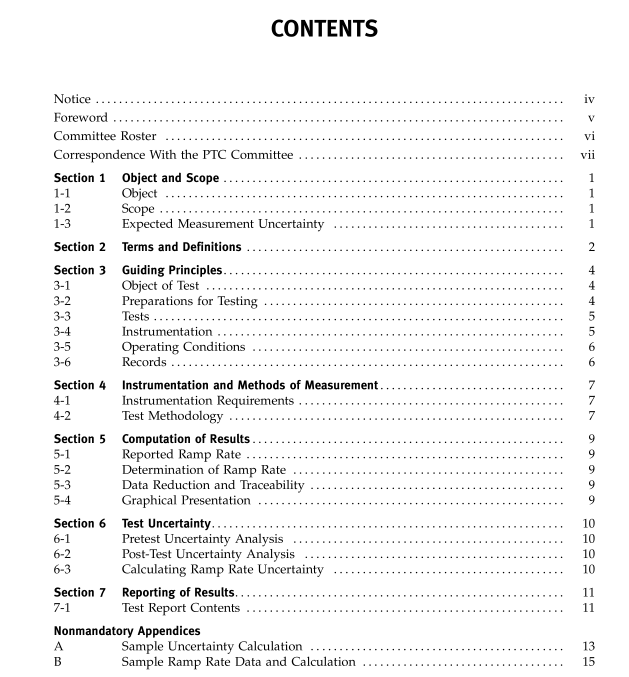ASME PTC 70:2009 pdf free download Ramp Rates Performance Test Codes
3-2.3 Preliminary Test Runs
Preliminarytestruns, withrecords, serve to determine if equipment is in suitable condition to test, to check instruments and methods ofmeasurement, to check ade- quacy of organization and procedures, and to train per- sonnel. All parties to the test may conduct reasonable preliminary test runs as necessary. Observations during preliminary test runs should be carried through to the calculation of results as an overall check of procedure, layout, and organization. If such preliminary test run complies with all the necessary requirements of this Code, it may be used as an official test run within the meaning of this Code.
3-3 TESTS
3-3.1 Preparation For acceptance and other official tests, the manufac- turer, supplier, and owner shall have reasonable oppor- tunity to examine the equipment, correct defects, and render the equipment suitable to test including manu- facturer prescribed commissioning procedures success- fully completed. The manufacturer, however, is not thereby empowered to alter or adjust equipment or con- ditions in such a way that regulations, contract, safety, or other stipulations are altered or voided. The manufac- turer may not make adjustments to the equipment for purpose of this test that may prevent immediate, contin- uous, and reliable operation at all capacities or outputs under all specified operating conditions as would other- wise be present, unless agreed to by all parties. Any actions taken that are material to the object of this Code must be documented and immediately reported to all parties to the test.
3-3.2 Starting and Stopping Initial acceptance tests shall be conducted as promptly as possible following initial equipment operation, com- pletion of commissioning, controls tuning, and prelimi- nary testruns. Other official tests, such as demonstration to grid system officials ofthe plantramp rate capabilities shall be conducted at mutually agreeable times. The equipment should be operated for sufficient time to demonstrate that intended pretest conditions have been established, e.g., steady state at agreed-to operating con- ditions. Agreement on procedures and time should be reached before commencing the test. If gradual or asymptotic approach to an endpoint condition is required, prior agreement to necessary closeness for acceptance on having reached the end condition should be determined. If the test end condition may exhibit variation, such as a small continuous plant output change when connected to a noisy or unstable grid, the method for determining end of test considering the variation will be previously agreed to. An example is the first time passing of endpoint condition ends the test. (The subsequent momentary reductions below end condition being ignored.) Follow the pretest agreement if the ramp commences and/or ceases at precise points 5 and the unit load attains steady state or the unit load increases or decreases through those points without stopping.
3-3.3 Readjustments Once testing has started, readjustments to the equip- ment that can influence the results of the test shall require repetition of any test runs conducted prior to the readjustments. Adjustments that are inappropriate for reliable and continuous operation following a test under any and all of the specified outputs and operating conditions shall not be made for the purpose of a test.
3-3.4 Data Collection Data shall be taken by automatic data collecting equipment or by a sufficient number of competent observers. Automatic data logging and advanced instru- ment systems shall be calibrated to the required accu- racy. No observer shall be required to take so many readings that lack of time may result in insufficient care and precision. Consideration shall be given to specifying duplicate instrumentation and taking simultaneous readings for certain test points to attain the specified accuracy of the test.
3-3.5 Conduct of Test The parties to the test shall designate a person to directthe testhereafter called testcoordinator. Intercom- munication arrangements among all test personnel, all test parties, and the test coordinator shall be established. Complete written records of the test, including details that at the time may seem irrelevant, shall be reported. If a commercial test, accredited representatives of the purchaserandthemanufacturer, supplier, orgridsystem officials should be present at all times to assure them- selves that the tests are being conducted with the test code and prior agreement.
ASME PTC 70:2009 pdf free download
